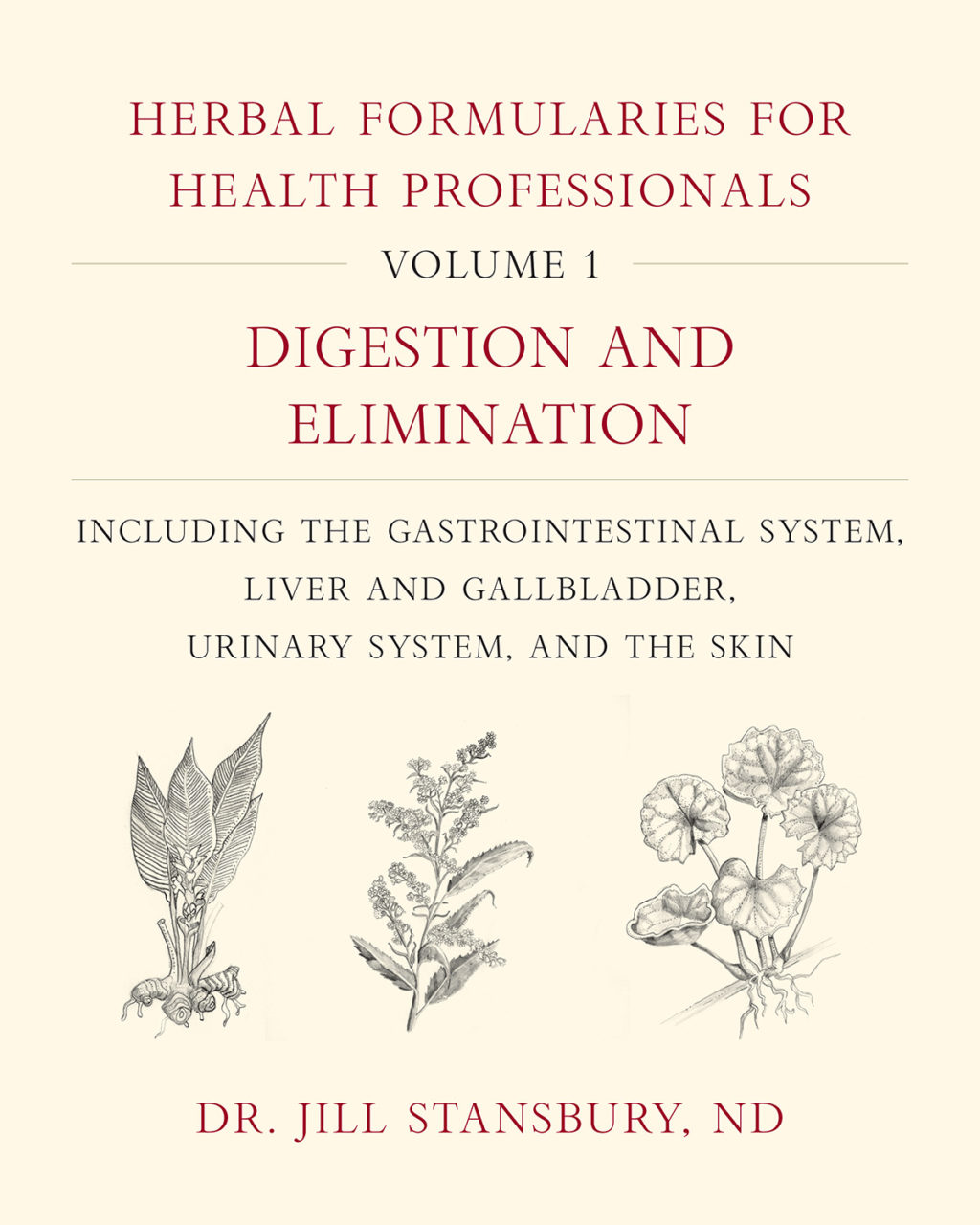Herbal
Formularies for Health Professionals, Volume 1: Digestion and Elimination by Jill Stansbury.
White River Junction, VT: Chelsea Green Publishing; 2018. Hardcover, 352 pages.
ISBN: 9781603587075. $59.95.
 Herbal Formularies
for Health Professionals by Jill Stansbury, ND, is a welcome and long-awaited
addition to the library of botanical medicine resources for health
practitioners. Volume 1 is the first book of a planned series of five books.
This first volume focuses on the gastrointestinal system, liver and
gallbladder, urinary system, and the skin. The second volume, Circulation and Respiration, was
published in September 2018. Herbal Formularies
for Health Professionals by Jill Stansbury, ND, is a welcome and long-awaited
addition to the library of botanical medicine resources for health
practitioners. Volume 1 is the first book of a planned series of five books.
This first volume focuses on the gastrointestinal system, liver and
gallbladder, urinary system, and the skin. The second volume, Circulation and Respiration, was
published in September 2018.
Volume
1 is outstanding in that it provides an overview of herbal formulation that is
based on herbal tradition, the author’s clinical experience, and current
scientific understanding. This book can certainly be used as a go-to reference
for herbal formulas. At its core, and by providing hundreds of formulas,
Stansbury has bestowed readers with a clinically pragmatic guide to perfecting their
own herbal formulating. As such, this book will be useful for both the
beginning and the experienced practitioner.
The
book begins with an introduction to herbal formulation. In Chapter 1, the
author presents an elegantly simple strategy for herbal formulating based on the
combination of base herbs, specific herbs, and synergistic herbs. The base, or
lead, herb nourishes the main organ system affected. The specific herb is
precisely matched to a certain aspect of the patient’s health concern, and the
synergistic herb supports the base herb’s effect by addressing other contributing
factors. This triangle strategy underlies the many herbal formulas spread
throughout the remaining chapters. It also speaks to the importance of knowing
individual herbs in order to place them into effective formulas. To that end,
while the emphasis of Herbal Formularies
for Health Professionals is, rightly so, formulas, information about
individual herbs also is found throughout the book.
The
last four chapters focus on conditions associated with the “emunctory” organs, a
medical term that refers to the organs of elimination. Chapter topics include
gastrointestinal and biliary conditions, liver and gallbladder conditions,
renal and urinary conditions, and dermatologic conditions. Within each of these
chapters, health conditions are discussed and a variety of herbal formulas presented.
For
instance, there is a section in the gastrointestinal and biliary conditions
chapter on herbal formulas for irritable bowel syndrome (IBS). There is a brief
discussion of pathophysiology and the factors that contribute to IBS, followed
by an explanation and listing of carminative (flatulence-relieving) herbs,
which are essential to the management of IBS. From there, specific herbal
formulas are presented for the following: IBS with painful gas and cramping,
IBS-diarrhea predominant, IBS with blood and/or mucus diarrhea,
IBS-constipation predominant, IBS stimulated by stress, IBS in allergic
individuals, and IBS in association with PMS or hormonal fluctuations. Each
herbal formula includes a suggested dosage, an explanation of the formula’s
purpose, and a description of the included herbs. Throughout the book, most
formulas emphasize Western herbs, although there are some traditional Asian
herbs included as well.
Using
this template, the reader gains immediate understanding of, in the example of IBS,
the versatility and importance of herbs such as chamomile (Matricaria chamomilla, Asteraceae) and licorice (Glycyrrhiza glabra, Fabaceae) and the
specific IBS indications for herbs such as yarrow (Achillea millefolium, Asteraceae), lemon balm (Melissa officinalis, Lamiaceae), and dong quai (Angelica sinensis, Apiaceae) to name
just a few. Furthermore, the reader comes away with many formulas that specifically
target unique presentations of various symptoms. These formulas can be
incorporated immediately into clinical practice. This pattern of presentation
is followed throughout the book.
As
the above example illustrates, this book is comprehensive in both its breadth
and its depth. After the discussion of each condition, there is an alphabetical
listing of herbs used for that condition, each with a monograph. At the end of
the volume, there is a listing of scientific names and corresponding common
names, as well as a glossary of therapeutic terms. The index for this volume is
outstanding and includes both conditions and herbs. Under each indexed herb,
its respective formulas are organized by condition. The index itself is an
incredible resource.
Stansbury
is an experienced practitioner who has gleaned her wisdom from her global
travels to indigenous communities, devoted study of traditional herbal texts
and current scientific literature, conversations with herbalist peers, and her
own clinical practice. She has, quite remarkably, distilled this vast treasure
trove of knowledge into a gem of practical clinical application. If you are a
health practitioner looking for trustworthy and clinically tested herbal
formulas for digestion- and elimination-related conditions, the first volume of
Herbal Formularies for Health
Professionals is a must-have.
At
the conclusion of the introduction, the author writes: “It is my sincere hope
that this book helps you in your clinical work and efforts to heal people.” Dr.
Stansbury, you have succeeded, and I, for one, thank you for this amazing gift.
I hope that this book finds itself in the offices of all health practitioners
who aspire to harness the amazing healing potential of plants. Their patients
will be better for it.
—Lise
Alschuler, ND, FABNO
Professor of Clinical Medicine, University of Arizona
Center for Integrative Medicine
Executive Director, TAP Integrative
Tucson, Arizona
|